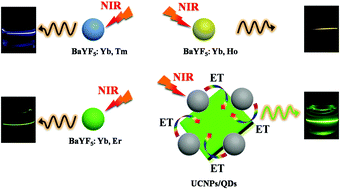Strong upconversion emission in CsPbBr3 perovskite quantum dots through efficient BaYF5:Yb,Ln sensitization†
Abstract
Owing to their remarkable optical properties, all-inorganic cesium lead halide perovskite CsPbX3 (X = Br, Cl, and I) quantum dots (QDs) have emerged as promising materials for a variety of applications, such as solar cells and light-emitting diodes. However, these perovskite QDs can only be excited under short-wavelength light with high power below 600 nm, which limits their applications. Herein, we demonstrate an effective strategy to realize near-infrared (NIR) pumping for CsPbBr3 QDs through energy transfer from lanthanide-doped upconversion nanoparticles (UCNPs). UCNP/QD pairs with different molar ratios were synthesized by an in situ growth method. Transmission electron microscopy images show that the configuration of the assembly is dependent on the molar ratio of the two units which are distributed homogenously with high surface contact. A high energy transfer efficiency ∼100% from the UCNP donors to the QD acceptors is achieved, leading to intense green emission from the perovskite CsPbBr3 QDs under NIR laser light even in a liquid suspension. Additionally, the high photostability of CsPbBr3 QDs under NIR irradiation suggests that this strategy can be a critical step for the development of perovskite-based functional emitters or devices with long-term operational stability.



 Please wait while we load your content...
Please wait while we load your content...